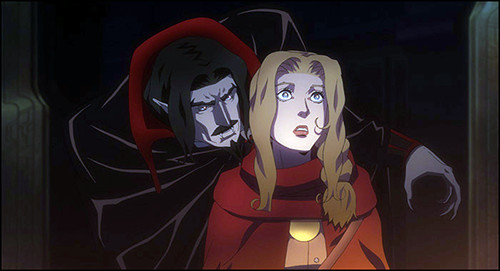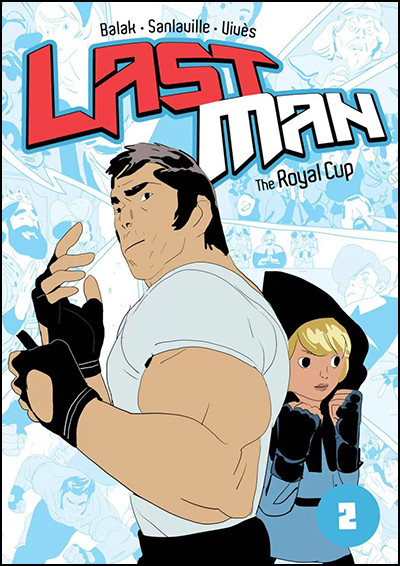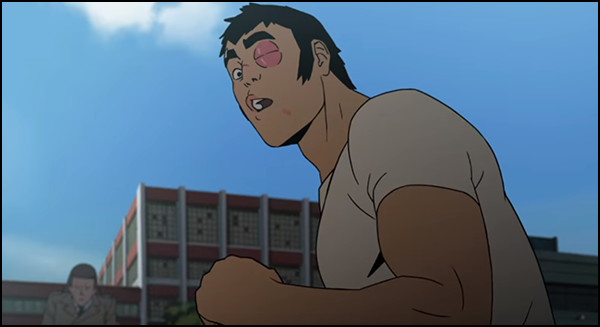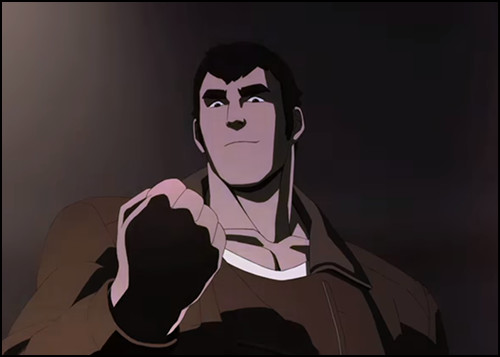The Mike Toole Show
Lastman, Standing
by Mike Toole,
Earlier this year I was at the Crunchyroll Expo, where I hosted a bunch of discussion panels and presented a couple of my own. The homogenous look and omnipresent Crunchyroll branding took some getting used to, but it was ultimately an energetic and well-run show, a deft mix of the stuff I like (manga and anime creators!), things that are more broadly popular at anime cons (dub voice actors, YouTube stars), and of course, Johnny Weir. It was a really solid first-year event, is what I'm saying.
During the run of the show, I met up with ANN's talented editorial tag-team of Zac Bertschy and Jacob Chapman (which tag team are they, actually? I'm thinking the Midnight Express, specifically as they appear in this photo, which means that our publisher Chris is a very tall Jim Cornette. Someone get him a tennis racket!), who were there both to cover the show and lend their expertise towards hosting a few of the panels. Zac had just hosted a Q&A with some of the Castlevania animation staff, including director Sam Deats. It was timely, since the show had recently come out and plenty of anime fans were buzzing about it. I myself was getting ready to check out Lastman, a Kickstarter-fueled action cartoon based on a popular French comic. “We should be covering that show too, shouldn't we?” Zac mused aloud. Well, I've finally seen Lastman, and since this is my column where I get to do what I want, guess what? We are covering it!

What is anime? Six years ago in this very spot, I posed this question, mostly to make you all start hollering “Anime is: straight from Japan!” in your vast, empty houses. Half a decade on, fans still like to ask that question-- but it has subtly changed. When I posed the question, I was specifically referring to co-productions, fare financed and developed outside of Japan but largely animated there. For me, the eternal exemplar of this practice is Ulysses 31, a fusion of charmingly baroque French sci-fi and intricate Japanese mecha and world design that is every bit as entertaining as its pounding, kaleidoscopic opening teases. A more recent example might be the Marvel/Madhouse superhero collaborations, which have the same “scripted in the west, animated in the east” deal going, even if the quality doesn't make it all the way to the screen.
But nowadays, when people ask if something oughta be called anime, they're often talking about new hits like Voltron: Legendary Defender, a complicated example that has roots in an American bowdlerization of an anime series, but contains no actual art or animation that is made in Japan. I get it, though: instead of squinting at the show's credits, looking for a Japanese studio name, these viewers are kinda keying in on the show's origins, the complexity of the writing, the way the characters look… that kinda stuff. There was a time, about a decade ago, just before the anime and manga bubble popped, when a number of western companies scrambled to make comics and animation that kinda looked like anime and manga, but only at first glance. Nobody was really fooled by productions like Code Lyoko and My Dead Girlfriend and, well, Teen Titans. There were no pointed social media arguments about whether or not Totally Spies! counted as anime, just because it tried to look like it. (Do not laugh too hard at Totally Spies!, a show that thundered right along for six seasons and 156 episodes, a theatrical film, and a 52-episode spinoff. Most anime shows wish they had that kind of staying power!)

But earlier this year, the “Is it anime?” argument kept popping up around Netflix's Castlevania series. Maybe it was because it has origins in a Japanese video game franchise. Maybe it was because there are a few Japanese names mixed in with the show's American production team. Maybe it's because, despite lacking the flair and complexity of character designer Ayami Kojima's work, the team tries to follow her lead, which doesn't become too obvious until Alucard shows up. I think it's because Castlevania looks like anime, in a way that most of the earlier anime-esque western shows didn't; when the show's trailer appeared, myself and a lot of friends assumed it was animated in Japan, because it just looked like it was.
To dig a little deeper into this idea, you need to ask: what draws western animation lovers to anime? There are some broad answers—the complexity of the character artwork, for example, or the ongoing, serial nature of the stories. Speaking for myself, the biggest reason I broke for anime as a kid was all down to the way the camera moved. It wasn't just the cool swoops and tracking shots, though those certainly caught my eye, but an overall quality to the artists' shot selection that made even cheap, rushed shows feel more vibrant, more like big-deal movies, with higher stakes. There was a cinematic feel to anime that western cartoons just lacked. American cartoons of the 80s, even ones with pretty extensive amounts of their animation produced in Japan, all seemed to be aping superhero or newspaper comics, and not the dynamism of 70s work by the likes of Neal Adams and Dave Cockrum, but flatter, simpler stuff from the 50s.
Castlevania has that cinematic sensibility. So does Lastman. Lastman has its origins in an ongoing French comic series, which happens to be very conveniently republished in English in a black and white, squarebound, $9.99/book format that should feel comfortingly familiar to manga buyers. Its creators, a 3-man unit consisting of comic artist Bastian Vivès, animator Yves “Balak” Bigerel, and illustrator Michaël Sanlaville, readily acknowledge their creation's manga parallels—they're even set up to produce chapters on a weekly basis for the magazine KSTЯ, just like a series in Shonen Jump! But the creators are just as quick to point out that they're not trying to make their own manga—instead, their intention is to marry manga storytelling techniques together with Hollywood movie tropes, with their own distinctive styles working together to create something unique.

Lastman is only marginally similar to most action manga I've read, but I think action manga fans will like it. The story takes place in a medieval kingdom where the inhabitants, young and old, are preparing for a tournament. But this isn't a typical high-stakes shonen manga tourney. In this tournament, the best 2-person fighting team, a pair of combatants who must master not just martial arts but a kind of elemental magic, compete for the chance to win a valuable magical cup and an audience with the king. The tournament is a cultural event—it has broad participation from a number of magic-using pugilists from tweens to seniors, most of whom expect to lose, but still have some fun and pick up some skills in the bargain. The more powerful adult fighters tend to humor the younger and weaker participants, and watch avidly to see if the kids can score an upset or launch a surprising magical attack.
One of these younger fighters is Adrian Velba, a shrimp of a kid who takes his martial arts seriously, but brings up the rear of his local fighting troupe. He's enthralled by the atmosphere of the tournament and longs to compete, but his equally underpowered partner takes up sick—and that's when a character from an entirely different genre strides into the scene. He's a bit worn down but muscular and handsome, a rugged action story hero who makes some quips (nobody understands his slang) and asks for some smokes (nobody's heard of cigarettes here). Then, needing a partner to enter the ring, the rugged hero, Richard Aldana, points to the hopeless kid. Just like that, Adrian's Team No-Hope are dark horses.
With that move, the Lastman creative team takes the whole YA fantasy formula and dumps it all over the room, mixing in elements of western sagas, road trip movies, martial arts tales, and high adventure. It's pretty impressive stuff from a trio of 2000s art school punks who can't resist naming some of the characters after their favorite pin-up models! The first six volumes of Richard and Adrian's excellent adventures are available in North America; the artists have promised that the next six will also tell a complete story arc, and they've got four in the bag back home in France. I'm hoping that the US publisher is waiting for that arc to finish so they can publish the next bit all at once. But the comic wasn't just a notable, genre-bending hit—it laid the groundwork for the animated series.

I found out about Lastman via Kickstarter, but it was one of those Kickstarters that doubled as a marketing exercise. The show itself was always going to happen, but the success of the crowdfunding would help to both drive additional interest in the series and expand its production budget, allowing for more episodes to be made. This is a nuance of Kickstarter that is often misunderstood, even though the same approach fueled the anime OVA Under the Dog; it's not always about the money itself, but about leveraging the platform to drive interest in the show. With Lastman, the approach worked—they didn't raise enough cold, hard cash to finish the whole story, but what they did raise helped secure some additional partnerships that got the series finished.
The animated Lastman is a prequel that gives us some background on where this Aldana character came from. The place where he came from is Paxtown, a “real world” city that feels America-ish, but not precisely like America, which is fine because We Never Learn which country Paxtown is in, and it doesn't use US dollars as currency. Here, Richard is a street tough and aspiring boxer, an affable but dumb kid surrounded by a host of action movie character types. There's a beloved mentor who gets killed under mysterious circumstances. There's a hard-punching, trash-talking fighting partner. There's a local crime boss who comes off as a fusion of Vito Corleone and Suge Knight. There's a put-upon police detective who's just trying to get results. There's a mysterious brother to Aldana's mentor, one skilled in the dark arts. There's a kid-sister type with a horrifying secret. There's a bloodthirsty cult headed up by weird, powerful magic-users, and… okay whoa, Lastman is doing that genre-mixing thing again.

What puts Lastman over, in both comic and animation form, is Richard Aldana himself. He's got a lot of the stuff that these stories demand—big muscles, wisecracks, and a palooka-esque invincibility that always sees him getting beaten black and blue, but somehow winning out in the end. What makes Richard stand out is the fact that he's nice—not in the typical comic book-y nice-to-old-folks deal, but in the way that he palpably cares about the people around him and wants to help them out, assuming he's not busy starting a bar fight. It's easy to make a by-the-numbers fightman; the challenge is in making the character likeable. Here, the Lastman team win out.
As for the show's visuals, they've got that cinematic look that I enjoy in spades. The animation kinda needs strong storyboarding and art direction, because there's not a whole lot of it—Lastman is produced by a relatively lean staff, so outside of big action set pieces, it has to rely on style over motion. But this creates an economy to the show's art and animation that is undeniably appealing; the approach works. Does that mean, then, that Lastman is anime? Hey man, it has a guy that worked on anime in the staff!! Nah, I wouldn't call it anime, in no small part because I remain wary of the “anime” name turning into some sort of catch-all word for action cartoons. But I think that animation fans will like Lastman for the same reasons that they like Japanese anime, and that's your difference-maker.
We gotta keep pondering that question, even if some of us are tired of it. Is Avatar: The Last Airbender anime? Best Buy sure thinks so, because the stores always have it sitting next to the Ghibli movies and Naruto box sets. Is Neo Yokio really anime, just because it got some character work and storyboards from Japan? Opinions seem split on that one, just like they are on whether Toblerone bars are good or bad. Is the forthcoming Cannon Busters series anime? Despite having most of its work done in Japan, creator LeSean Thomas thinks anime is going global. Is My Life Me anime?! I expect readers of this site to say no, more often than not. After all, shows like Lastman and Castlevania simply aren't from Japan, and don't have participation from anime creators. But some of these shows are really starting to use the same visual and storytelling building blocks that anime does in a very appealing way, making new animation that anime fans will dig. I'm ready for more Lastman—and ready for more animation (and more anime!) like it.
discuss this in the forum (17 posts) |